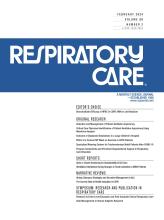This article requires a subscription to view the full text. If you have a subscription you may use the login form below to view the article. Access to this article can also be purchased.
Exacerbation of COPD is characterized by increased airway inflammation and mucus production, which leads to increased airway resistance and subsequent expiratory flow limitation.1,2 This results in a rapid shallow breathing pattern that shortens the time available for expiration (lung emptying) and further worsening lung hyperinflation.3 Indeed, the time for expiration is no longer sufficient to allow end-expiratory lung volume to reach its natural relaxation volume, further aggravating lung hyperinflation. Lung hyperinflation leads to intrapulmonary pressure remaining positive at the end of expiration, generating what is called intrinsic PEEP.
Treatment of exacerbation of COPD includes pharmacologic therapy and noninvasive respiratory support. Inhaled β2 agonists and anticholinergic bronchodilators are the cornerstone of pharmacologic therapy, reducing airway resistance, lung hyperinflation, and subsequent gas trapping as well as improving respiratory symptoms in patients with COPD exacerbations. Short-acting inhaled β2 agonists with or without short-acting anticholinergics are strongly recommended as the initial bronchodilators to treat an exacerbation.4
The standard delivery of bronchodilators is carried out with a gas flow of air or oxygen of ∼6 L/min through a face mask by using a jet nebulizer. However, in patients with a severe exacerbation of COPD with respiratory acidosis, noninvasive ventilation (NIV) is strongly recommended as the first line of respiratory support.5 NIV improves gas exchange and decreases breathing frequency and work of breathing by unloading inspiratory muscles and by mitigating intrinsic PEEP. This results in a decreased risk of intubation, shortened hospital length of stay, and decreased risk of mortality.6 In patients treated with NIV for acute hypercapnic respiratory failure, bronchodilators can be delivered through a standard oxygen mask by using a jet nebulizer between NIV sessions or during NIV.7 However, delivery of bronchodilators under NIV is subject to alteration by positive pressure.
High-flow nasal cannula …
Correspondence: Jean-Pierre Frat MD, CHU de Poitiers, Service de Réanimation Médicale, 2, rue de la Milétrie, CS 90577, 86021 POITIERS cedex, France. E-mail: jean-pierre.frat{at}chu-poitiers.fr
Pay Per Article - You may access this article (from the computer you are currently using) for 1 day for US$30.00
Regain Access - You can regain access to a recent Pay per Article purchase if your access period has not yet expired.







